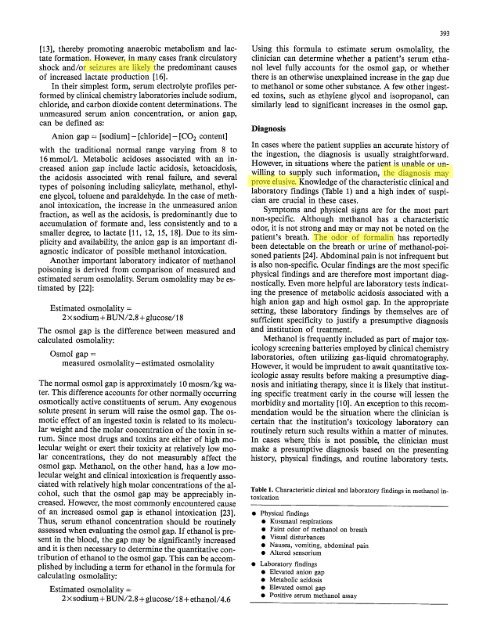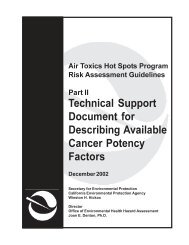Methanol poisoning - While Science Sleeps
Methanol poisoning - While Science Sleeps
Methanol poisoning - While Science Sleeps
Create successful ePaper yourself
Turn your PDF publications into a flip-book with our unique Google optimized e-Paper software.
393<br />
[13], thereby promoting anaerobic metabolism and lactate<br />
formation. However, in many cases flank circulatory<br />
shock and/or seizures are likely the predominant causes<br />
of increased lactate production [161.<br />
In their simplest form, serum electrolyte profiles performed<br />
by clinical chemistry laboratories include sodium,<br />
chloride, and carbon dioxide content determinations. The<br />
unmeasured serum anion concentration, or anion gap,<br />
can be defined as:<br />
Anion gap = [sodium]- [chloride]- [CO 2 content]<br />
with the traditional normal range varying from 8 to<br />
16mmol/1. Metabolic acidoses associated with an increased<br />
anion gap include lactic acidosis, ketoacidosis,<br />
the acidosis associated with renal failure, and several<br />
types of <strong>poisoning</strong> including salicylate, methanol, ethylene<br />
glycol, toluene and paraidehyde. In the case of methanol<br />
intoxication, the increase in the unmeasured anion<br />
fraction, as well as the acidosis, is predominantly due to<br />
accumulation of formate and, less consistently and to a<br />
smaller degree, to lactate [11, 12, 15, 18]. Due to its simplicity<br />
and availability, the anion gap is an important diagnostic<br />
indicator of possible methanol intoxication.<br />
Another important laboratory indicator of methanol<br />
<strong>poisoning</strong> is derived from comparison of measured and<br />
estimated serum osmolality. Serum osmolality may be estimated<br />
by [22]:<br />
Estimated osmolality =<br />
2 • sodium + BUN/2.8 + glucose/18<br />
The osmol gap is the difference between measured and<br />
calculated osmolality:<br />
Osmol gap =<br />
measured osmolality-estimated osmolality<br />
The normal osmol gap is approximately 10 mosm/kg water.<br />
This difference accounts for other normally occurring<br />
osmotically active constituents of serum. Any exogenous<br />
solute present in serum will raise the osmol gap. The osmotic<br />
effect of an ingested toxin is related to its molecular<br />
weight and the molar concentration of the toxin in serum.<br />
Since most drugs and toxins are either of high molecular<br />
weight or exert their toxicity at relatively low molar<br />
concentrations, they do not measurably affect the<br />
osmol gap. <strong>Methanol</strong>, on the other hand, has a low molecular<br />
weight and clinical intoxication is frequently associated<br />
with relatively high molar concentrations of the alcohol,<br />
such that the osmol gap may be appreciably increased.<br />
However, the most commonly encountered cause<br />
of an increased osmol gap is ethanol intoxication [23].<br />
Thus, serum ethanol concentration should be routinely<br />
assessed when evaluating the osmol gap. If ethanol is present<br />
in the blood, the gap may be significantly increased<br />
and it is then necessary to determine the quantitative contribution<br />
of ethanol to the osmol gap. This can be accomplished<br />
by including a term for ethanol in the formula for<br />
calculating osmolality:<br />
Estimated osmolality =<br />
2 x sodium + BUN/2.8 + glucose/18 + ethanol/4.6<br />
Using this formula to estimate serum osmolality, the<br />
clinician can determine whether a patient's serum ethanol<br />
level fully accounts for the osmol gap, or whether<br />
there is an otherwise unexplained increase in the gap due<br />
to methanol or some other substance. A few other ingested<br />
toxins, such as ethylene glycol and isopropanol, can<br />
similarly lead to significant increases in the osmol gap.<br />
Diagnosis<br />
In cases where the patient supplies an accurate history of<br />
the ingestion, the diagnosis is usually straightforward.<br />
However, in situations where the patient is unable or unwilling<br />
to supply such information, the diagnosis may<br />
prove elusive. Knowledge of the characteristic clinical and<br />
laboratory findings (Table 1) and a high index of suspician<br />
are crucial in these cases.<br />
Symptoms and physical signs are for the most part<br />
non-specific. Although methanol has a characteristic<br />
odor, it is not strong and may or may not be noted on the<br />
patient's breath. The odor of formalin has reportedly<br />
been detectable on the breath or urine of methanol-poisoned<br />
patients [24]. Abdominal pain is not infrequent but<br />
is also non-specific. Ocular findings are the most specific<br />
physical findings and are therefore most important diagnostically.<br />
Even more helpful are laboratory tests indicating<br />
the presence of metabolic acidosis associated with a<br />
high anion gap and high osmol gap. In the appropriate<br />
setting, these laboratory findings by themselves are of<br />
sufficient specificity to justify a presumptive diagnosis<br />
and institution of treatment.<br />
<strong>Methanol</strong> is frequently included as part of major toxicology<br />
screening batteries employed by clinical chemistry<br />
laboratories, often utilizing gas-liquid chromatography.<br />
However, it would be imprudent to await quantitative toxicologic<br />
assay results before making a presumptive diagnosis<br />
and initiating therapy, since it is likely that instituting<br />
specific treatment early in the course will lessen the<br />
morbidity and mortality [10]. An exception to this recommendation<br />
would be the situation where the clinician is<br />
certain that the institution's toxicology laboratory can<br />
routinely return such results within a matter of minutes.<br />
In cases where this is not possible, the clinician must<br />
make a presumptive diagnosis based on the presenting<br />
history, physical findings, and routine laboratory tests.<br />
Table 1. Characteristic clinical and laboratory findings in methanol intoxication<br />
9 Physical findings<br />
9 Kussmaul respirations<br />
9 Faint odor of methanol on breath<br />
9 Visual disturbances<br />
9 Nausea, vomiting, abdominal pain<br />
9 Altered sensorium<br />
9 Laboratory findings<br />
9 Elevated anion gap<br />
9 Metabolic acidosis<br />
9 Elevated osmol gap<br />
9 Positive serum methanol assay







